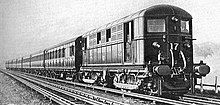
The Metropolitan line, colloquially known as the Met, is a London Underground line between Aldgate in the City of London and Amersham and Chesham in Buckinghamshire, with branches to Watford in Hertfordshire and Uxbridge in Hillingdon. Printed in magenta on the tube map, the line is 41.4 miles (66.7 km) in length and serves 34 stations. Between Aldgate and Finchley Road, the track is mostly in shallow "cut and cover" tunnels, apart from short sections at Barbican and Farringdon stations. The rest of the line is above ground, with a loading gauge of a similar size to those on main lines. Just under 67 million passenger journeys were made on the line in 2011/12.
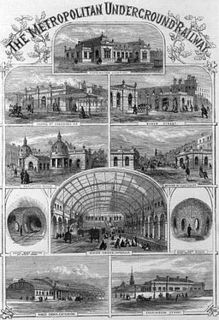
The Metropolitan Railway was a passenger and goods railway that served London from 1863 to 1933, its main line heading north-west from the capital's financial heart in the City to what were to become the Middlesex suburbs. Its first line connected the main-line railway termini at Paddington, Euston, and King's Cross to the City. The first section was built beneath the New Road using cut-and-cover between Paddington and King's Cross and in tunnel and cuttings beside Farringdon Road from King's Cross to near Smithfield, near the City. It opened to the public on 10 January 1863 with gas-lit wooden carriages hauled by steam locomotives, the world's first passenger-carrying designated underground railway.
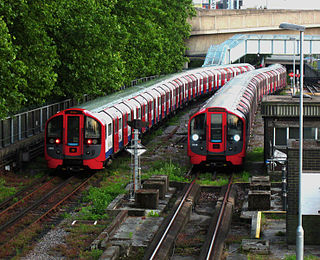
London Underground rolling stock includes the electric multiple-unit trains used on the London Underground. These come in two sizes, smaller deep-level tube trains and larger sub-surface trains of a similar size to those on British main lines. New trains are designed for the maximum number of standing passengers and for speed of access to the cars.

The Metropolitan District Railway, also known as the District Railway, was a passenger railway that served London from 1868 to 1933. Established in 1864 to complete an "inner circle" of lines connecting railway termini in London, the first part of the line opened using gas-lit wooden carriages hauled by steam locomotives. The Metropolitan Railway operated all services until the District Railway introduced its own trains in 1871. The railway was soon extended westwards through Earl's Court to Fulham, Richmond, Ealing and Hounslow. After completing the inner circle and reaching Whitechapel in 1884, it was extended to Upminster in Essex in 1902.
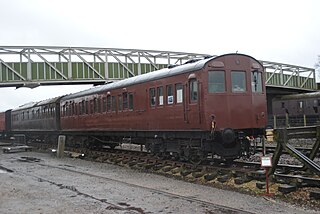
The T Stock was a series of electric trains originally built in various batches by Metropolitan-Vickers and the Birmingham Railway Carriage and Wagon Company for the Metropolitan Railway in 1927–31 for use on electric services from Baker Street and the City to Watford and Rickmansworth, though rarely some worked on the Uxbridge branch.

Rickmansworth is an interchange railway station in Rickmansworth, Hertfordshire, northwest of central London, served by the London Underground Metropolitan line and by Chiltern Railways. It is one of the few London Underground stations beyond Greater London and as a consequence is in Travelcard Zone 7. The station is a good location to alight from to explore the Chess Valley.

The Metropolitan Railway E Class is a class of 0-4-4T steam locomotives. A total of seven locomotives were built between 1896 and 1901 for the Metropolitan Railway: three by the railway at their Neasden Works and four by Hawthorn Leslie and Company in Newcastle upon Tyne.

London Underground battery-electric locomotives are battery locomotives used for hauling engineers' trains on the London Underground network where they can operate when the electric traction current is switched off. The first two locomotives were built in 1905 for the construction of the Great Northern, Piccadilly and Brompton Railway, and their success prompted the District Railway to buy two more in 1909, which were the only ones built to the loading gauge of the subsurface lines. Following this, a number of battery vehicles were built by converting redundant motor cars, with the batteries placed in the unused passenger compartment. One exception to this was made by the City and South London Railway, who used a trailer car to hold the batteries, and wired them to a separate locomotive.

An electric multiple unit (EMU) is an electric train capable of operating in multiple with other EMUs that does not have a separate locomotive, typically passenger trains with accommodation in every vehicle and a driving position at each end. The term can also be used to describe a train such as the Advanced Passenger Train that was a permanent formation with a non-driving power car. As of December 2010 two-thirds of the passenger carriages in Britain are formed in EMUs.
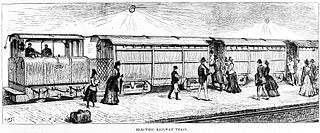
Electric locomotives were first used on the London Underground when the first deep-level tube line, the City and South London Railway (C&SLR), was opened in 1890. The first underground railways in London, the Metropolitan Railway (MR) and the District Railway (DR), used specially built steam locomotives to haul their trains through shallow tunnels which had many ventilation openings to allow steam and smoke to clear from the tunnels. It was impractical to use steam locomotives in the small unvented tubular tunnels of the deep-level lines, and the only options were rope haulage or electric locomotives.
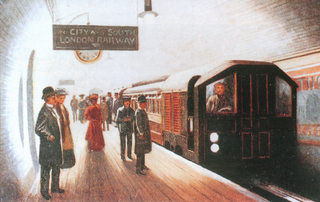
The Central London Railway Stock were electric multiple units composed of trailers that had been converted from carriages designed to be hauled by electric locomotives with new motor cars. The Central London Railway opened in 1900 with electric locomotives hauling wooden carriages, but the heavy locomotives caused vibrations that could be felt in the buildings above the route. Following investigation it was found that conversion to electric multiple units solved the problem, so new motor cars were bought and replaced all the locomotives by June 1903. Trains normally ran with six-cars, four trailers and two motor-cars, although some trailers were equipped with control equipment to allow trains to be formed with three cars.
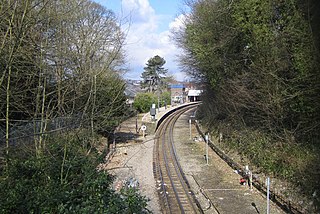
The Chesham branch is a single-track railway branch line in Buckinghamshire, England, owned and operated by the London Underground. It runs from a junction at Chalfont & Latimer station on the Metropolitan line for 3.89 miles (6.26 km) northwest to Chesham. The line was built as part of Edward Watkin's scheme to turn his Metropolitan Railway (MR) into a direct rail route between London and Manchester, and it was envisaged initially that a station outside Chesham would be an intermediate stop on a through route running north to connect with the London and North Western Railway (LNWR). Deteriorating relations between the MR and LNWR led to the MR instead expanding to the northwest via Aylesbury, and the scheme to connect with the LNWR was abandoned. By this time much of the land needed for the section of line as far as Chesham had been bought. As Chesham was at the time the only significant town near the MR's new route, it was decided to build the route only as far as Chesham, and to complete the connection with the LNWR at a future date if it proved desirable. Local residents were unhappy at the proposed station site outside Chesham, and a public subscription raised the necessary additional funds to extend the railway into the centre of the town. The Chesham branch opened in 1889.
District Railway steam locomotives were used on London's Metropolitan District Railway. When in 1871 the railway needed its own locomotives, they ordered twenty four condensing steam locomotives from Beyer Peacock similar to the A Class locomotives the Metropolitan Railway was using on the route. As they were intended for an underground railway, the locomotives did not have cabs, but had a weatherboard with a bent-back top and the back plate of the bunker was raised to provide protection when running bunker first.
London's Metropolitan Railway (MR) amalgamated with other underground railways, tramway companies and bus operators on 1 July 1933, to form the London Passenger Transport Board (LPTB); the MR became the Board's Metropolitan line.

Metropolitan Railway electric multiple units were used on London's Metropolitan Railway after the lines were electrified in the early 20th century.

District Railway electric multiple units were used on London's Metropolitan District Railway after the lines were electrified in the early 20th century.

The history of the District line started in 1864 when the Metropolitan District Railway was created to create an underground 'inner circle' connecting London's railway termini. The first part of the line opened using Metropolitan Railway gas-lit wooden carriages hauled by steam locomotives. The District introduced its own trains in 1871 and was soon extended westwards through Earl's Court to Fulham, Richmond, Ealing and Hounslow. After completing the 'inner circle' and reaching Whitechapel in 1884, it was extended to Upminster in East London in 1902. To finance electrification at the beginning of the 20th century, American financier Charles Yerkes took it over and made it part of his Underground Electric Railways Company of London (UERL) group. Electric propulsion was introduced in 1905, and by the end of the year electric multiple units operated all of the services.

Baldwin, the locomotive manufacturer, and Westinghouse, the promoter of AC electrification, joined forces in 1895 to develop AC railway electrification. Soon after the turn of the century, they marketed a single-phase high-voltage system to railroads. From 1904 to 1905 they supplied locomotives carrying a joint builder's plate to a number of American railroads, particularly for the New Haven line from New York to New Haven, and other New Haven lines. Westinghouse would produce the motors, controls, and other electrical gear, while Baldwin would produce the running gear, frame, body, and perform final assembly.

The London Underground opened in 1863 with gas-lit wooden carriages hauled by steam locomotives. The Metropolitan and District railways both used carriages exclusively until they electrified in the early 20th century. The District railway replaced all its carriages for electric multiple units, whereas the Metropolitan still used carriages on the outer suburban routes where an electric locomotive at the Baker Street end was exchanged for a steam locomotive en route.
